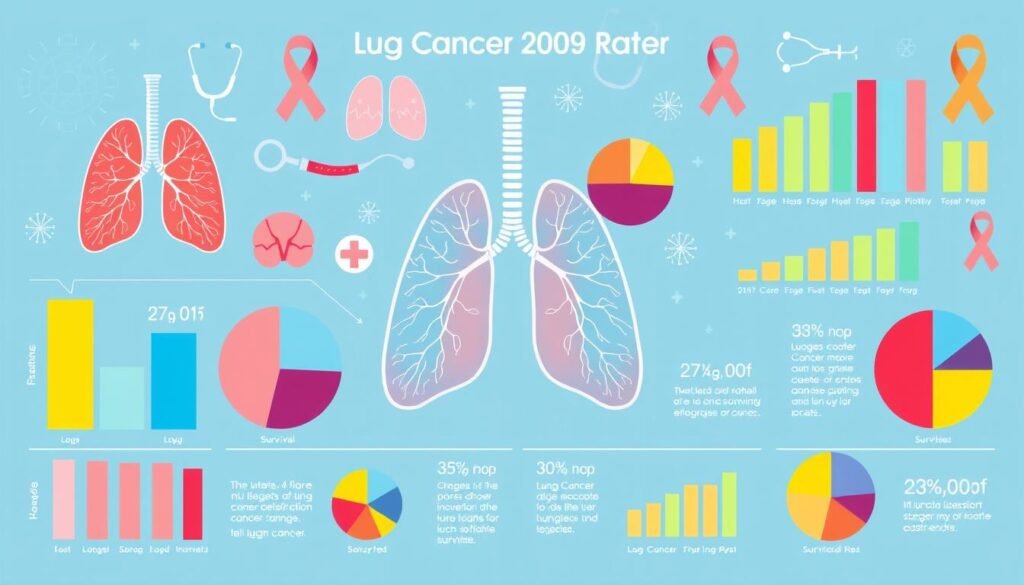Less than 16% of lung cancers are caught early. Yet, the five-year survival rate is only 18.6%. This makes lung cancer a leading cause of cancer deaths. How long someone with lung cancer can live depends on many things. These include the cancer’s stage and type, the person’s overall health, and available treatments. Even with these stats, each person’s situation is different. That’s why it’s vital for patients to talk to their doctors for advice that fits them. For more help, the Lung Foundation Australia provides useful information on lung cancer.
Key Takeaways
- Lung cancer has varying survival rates depending on the type and stage at diagnosis.
- Early detection can significantly improve life expectancy.
- Only a small percentage of lung cancer patients live beyond five years post-diagnosis.
- Advancements in treatment are playing a vital role in improving survival rates.
- Patients are encouraged to engage with healthcare professionals for tailored advice.
Understanding Lung Cancer Life Expectancy
Lung cancer life expectancy can be tricky. It depends on several factors, including the type of lung cancer and statistics. Patients with non-small cell lung cancer (NSCLC) or small cell lung cancer (SCLC) see different outcomes. This difference affects treatment choices and what patients might expect in the future.
Overview of Lung Cancer Statistics
Survival rates for lung cancer vary widely. They’re based on how early the cancer is found. About 20% of people live at least five years after a lung cancer diagnosis. Here’s a look at survival rates by stage:
| Stage | 5-Year Survival Rate |
|---|---|
| Stage 1 | Almost 65% |
| Stage 2 | Approximately 40% |
| Stage 3 | Around 15% |
| Stage 4 | Roughly 5% |
These numbers show why finding cancer early is key. A person’s overall health, how fit they are, and specific genetic factors also play a part. These can change someone’s chances of survival.
Differences Between Types of Lung Cancer
Most lung cancers are non-small cell lung cancer (NSCLC). Its survival rate over five years changes depending on the cancer stage:
- Localized: 65%
- Regional: 37%
- Distant: 9%
- All SEER stages combined: 28%
Small cell lung cancer (SCLC) is rarer but more aggressive. Its survival rates are lower:
- Localized: 30%
- Regional: 18%
- Distant: 3%
- All SEER stages combined: 7%
Lung Cancer Survival Rates by Stage
Lung cancer survival rates change a lot depending on when it’s found. Knowing the differences helps patients choose treatments and understand what to expect.
Stage 1 to Stage 4 Survival Rates
From 2013 to 2019, the average five-year survival rate was about 25.4 percent. For cancer that hasn’t spread, the survival rate is roughly 62.8 percent. But, if it has spread to nearby lymph nodes, the rate drops to 34.8 percent.
When lung cancer has spread far, survival plunges to around 8 percent. Non-small cell lung cancer (NSCLC) survival varies more clearly by stage:
| Stage | NSCLC Survival Rate |
|---|---|
| Stage 1 | 55% |
| Stage 2 | 35% |
| Stage 3 | 15% |
| Stage 4 | 5% |
About 55% of NSCLC patients find out they have it at stage 4. Small cell lung cancer (SCLC) shows the tough journey for patients found at different stages.
Comparison of Non-Small Cell and Small Cell Lung Cancer
NSCLC and SCLC survival rates differ significantly. For early-stage SCLC, survival is 30%. For cancer that’s spread nearby, it’s 18%. Far-spreading SCLC has only a 3% survival rate. The average five-year survival for SCLC is about 7%.
These numbers underline the importance of catching lung cancer early and treating it right away. Lung cancer is the top cause of cancer deaths. For more info on lung cancer rates and stages, check out this link.

How Long Does Someone With Lung Cancer Live
Finding out the life span of someone with lung cancer isn’t easy. It depends on a lot of things. This includes the stage of cancer when they find out and the treatments they can get. Early detection makes a big difference. It often leads to better chances of surviving longer.
Average Life Expectancy for Different Stages
The life span for those with lung cancer changes based on the stage. If someone has stage 1 lung cancer and doesn’t get treatment, they might live between 33 to 55 months. When the cancer is at stage 2, about 40% live for five years or more. But, for those with stage 3, the number goes down to 15%. And for stage 4, they might only have a few months to a little over a year. Only about 5% of stage 4 patients make it past five years. This shows how crucial early treatment is for a better outcome.
Impact of Treatment on Life Expectancy
Treatment can really change the odds of survival. The options include things like surgery, chemo, medicine that targets the cancer, and therapies that help the immune system fight the cancer. For example, the chance of surviving five years for localized non-small cell lung cancer (NSCLC) is around 65%. If the cancer has spread far, the survival rates go down. Sticking to treatment not only helps people live longer. It also makes life better. Getting help for symptoms is important too. It lets patients going through chemo, radiation, or immunotherapy have a better quality of life. If you want to know early signs of lung cancer, check out this website.

| Stage | 5-Year Survival Rate |
|---|---|
| Localized NSCLC | 65% |
| Regional NSCLC | 37% |
| Distant NSCLC | 9% |
| Localized SCLC | 30% |
| Regional SCLC | 18% |
| Distant SCLC | 3% |
Factors Affecting Lung Cancer Prognosis
Lung cancer’s outlook can highly depend on several key elements. Knowing these elements helps us understand possible outcomes better. Age and overall health are big influencers on survival chances. Young people tend to respond better to treatments. Meanwhile, older folks with other health issues often have a tougher time. This shows how crucial health status is when figuring out a patient’s future after being diagnosed with lung cancer.
Age and Health Status
Age and health conditions are vital in lung cancer’s outlook. Younger diagnosed individuals usually see better results. They are less likely to have other health problems. On the flip side, older patients, especially those with existing health issues, may find it harder to fight the disease and its treatments.
Genetic Factors and Tumor Mutations
Genetics play a big role in determining lung cancer outcomes. Tumor mutations heavily influence what treatments will work and how well. For example, certain mutations found through genetic testing can lead to specialized therapies that enhance the chances of survival. These mutations underscore the importance of tailored treatment plans. It’s key to ensure patients get the most effective care. Doctors check genetic changes in cancer cells to figure out the best treatment paths.

| Factor | Impact on Prognosis |
|---|---|
| Age | Younger patients generally have better outcomes. |
| Health Status | Comorbidities in older patients lead to poorer prognoses. |
| Genetic Factors | Specific tumor mutations can improve treatment effectiveness. |
Lung Cancer Treatment Options
Lung cancer treatment varies based on the cancer’s type and stage. It often includes surgery, chemotherapy, and immunotherapy. These options are key for patients and families deciding on a treatment path.
Surgery as a Primary Treatment
Surgery is commonly the first step in treating localized non-small cell lung cancer. Procedures like wedge resections, lobectomies, and pneumonectomies depend on tumor size and location. For early stages, especially stage 0 and I, surgery might cure without needing further treatment.
Role of Chemotherapy and Immunotherapy
Chemotherapy and immunotherapy are vital, especially for advanced lung cancer. Chemotherapy can destroy remaining cancer cells after surgery or shrink tumors before. Immunotherapy boosts the body’s defenses to attack cancer. Using these treatments with surgery improves survival and life quality for lung cancer patients.
Symptoms and Early Detection of Lung Cancer
Finding lung cancer early can greatly improve chances of beating it. Often, lung cancer shows symptoms that are easy to miss. Knowing what to look for means you can get help faster.
Common Symptoms of Lung Cancer
- Persistent cough that does not go away
- Shortness of breath or wheezing
- Unexplained weight loss
- Chest pain that worsens with deep breathing or coughing
- Fatigue
Importance of Early Detection Techniques
Finding lung cancer early is key to fighting it. Techniques like low-dose CT scans work well to spot lung cancer early. Doctors say people at higher risk should get checked regularly. This includes smokers and those with lung cancer in the family. Catching lung cancer early means treatment can start sooner, helping save lives.
Life Expectancy for Non-Small Cell Lung Cancer
Knowing how long patients with non-small cell lung cancer may live is key. This type of lung cancer makes up 80-85% of all cases, so it’s common. The stage of cancer when diagnosed matters a lot for life expectancy.
Stage-Specific Life Expectancy Data
How long people with NSCLC live varies by the stage of their cancer:
| Stage | 5-Year Survival Rate (%) | Average Life Expectancy (months) |
|---|---|---|
| Localized | 65 | 33-55 |
| Regional Spread | 37 | 12-28 |
| Distant Spread | 9 | 4-9 |
Patients with localized NSCLC have a much better chance, with a five-year survival rate of 65%. However, this rate goes down a lot for more advanced stages. Those with metastatic NSCLC usually have 4-9 months. This shows why finding cancer early is crucial.
Comparative Analysis with Small Cell Lung Cancer
NSCLC and small cell lung cancer (SCLC) are different in many ways. SCLC grows faster and has lower survival rates. If someone has advanced SCLC, they might live for 7-11 months. Without treatment, survival drops to 2-4 months. It shows how critical early treatment and regular checks are.
Long-Term Survival and Remission
Long-term survival from lung cancer is a big goal for patients and researchers alike. Many find hope in patient stories that share their fight and success against lung cancer. Statistics reveal that some outlive their diagnoses thanks to early action or strong treatment plans.
Patient Stories and Statistics
There are many stories of people beating the odds with their health. For example, someone with stage 1 non-small cell lung cancer (NSCLC) might have a survival rate between 70% to 92%. Stage 1a1 has a 92% survival rate, while stage 1b is around 68%. These numbers show the chance of living longer with the right treatment and effort.
Strategies to Improve Long-Term Survival
To increase chances of long-term survival, certain survival strategies are essential. It is crucial to eat healthily, exercise, and avoid smoking. Listening to your doctor and keeping up with new therapies can also make a big difference. Check-ups are important for catching any return of cancer early on. Moreover, with over 1,500 clinical trials for lung cancer treatments ongoing, there’s new hope for fighting the disease.
| Stage | 5-Year Survival Rate |
|---|---|
| Stage 1a1 | 92% |
| Stage 1a2 | 83% |
| Stage 1a3 | 77% |
| Stage 1b | 68% |
| Localized NSCLC | 65% |
Ultimately, beating lung cancer involves early diagnosis, effective treatment, and healthy living. For hints on spotting early signs of lung cancer, visit early detection techniques and seek medical advice swiftly.
Conclusion
Lung cancer life expectancy changes a lot based on several things. This includes the type of cancer, the stage when it’s found, treatment, and the patient’s health. For those with stage III and IV lung cancer, the five-year survival rate is between 9.5% to 16.8%. This highlights how key early and effective treatment is.
In the USA, 79% of lung cancer cases are found at these late stages. Raising awareness about early signs could lead to faster treatment. This might help patients live longer.
Personal treatment plans can also help. These plans might include chemo, radiation, or targeted therapies. Studies show that patients who follow through with their treatment plans often live longer. For those with non-small cell lung cancer, life expectancy varies. It depends on their age and the type of tumor. This shows why a plan made just for one person can help a lot.
It’s crucial for patients to talk openly with their doctors. They need to understand their treatment options well. By doing this, they can make choices that might lead to a better quality of life and longer survival. Many people fighting lung cancer could see better days ahead with the right steps.